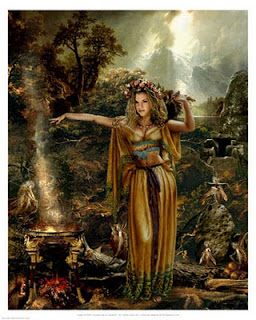September is going to be mostly Fairy myths and legends, After that
i will be doing Crypid posts until Halloween or shortly after,.....
Fairy, Fay, Wee folk or whatever you call them the little people are all around us.
Here is a little info on some of them.
The Daoine Sidhe..or Aos Si ...People of the mounds
Daoine Sidhe: Legend recounts that when the Milesians defeated the Tuatha dé Danann, they followed one of their leaders, Dagda, down under these earth mounds and became the Daoine Sidhe. They are the Trooping fairies and have their own regional kings and queens and owe allegiance to Finvarra and Onagh.
The aos sí (Irish pronunciation: [iːs 'ʃiː], "ees shee", older form aes sídhe is the Irish Gaelic term for a supernatural race in Irish mythology and Scottish mythology, (usually spelled Sìth, however pronounced the same) comparable to the fairies or elves.
They are said to live underground in fairy mounds, across the western sea, or in an invisible world that coexists with the world of humans. This world is described in the Book of Invasions (recorded in the Book of Leinster) as a parallel universe in which the aos sí walk amongst the living.
In the Irish language, aos sí means "people of the mounds" (the mounds are known in Irish as "the sídhe").
In Irish literature the people of the mounds are also called daoine sídhe; in Scottish mythology they are daoine sìth. They are variously said to be the ancestors, the spirits of nature, or Goddesses and Gods.
Some secondary and tertiary sources including well-known and influential authors such as W.B. Yeats refer to aos sí simply as "the sídhe" (lit.: mounds).
Sidhe are the hills that dot the Irish landscape.
In modern Irish the word is Si; in Scottish Gaelic sith in Old Irish side and the singular is sid.
In some English text the word sidhe is incorrectly used both for the mounds and the people of the mounds. However sidh in older texts refers specifically to "the palaces, courts, halls or residences" of the otherworldly beings that are said too inhabit them.
The fact that many of these sidhe have been found to be ancient burial mounds has contributed to the theory that the aos si were the pre-Celtic occupants of Ireland.
Aos si are said to be fierce protectors of the home's or territory whether a fairy hill, a Fairy Ring a special tree ( most times a Hawthorn or a particular loch or forest.
It is believed that entering these spaces will cause the aos si to retaliate in an effort to remove the people or objects that invaded their homes.
Many of these story's are often linked to changelings myth were the aos si are said to kidnapping trespassers or replacing their children with changelings as a punishment for their disrespect.
The aos si are often connected to certain times of year and hours; as the Gaelic Fairy world or spirit world is believed to come closer to the human world at the times of dusk and dawn, and the aos si aos s are easier to encounter. Some festivals such as Samhain (Halloween ) and Baltane,.. May 1st the beginning of summer ( May Day) are also associated with the aos si.



No comments:
Post a Comment